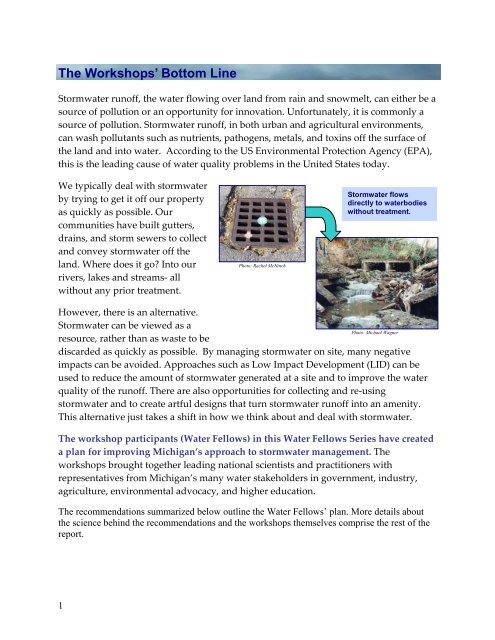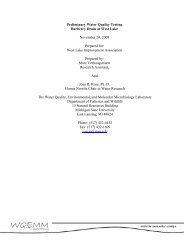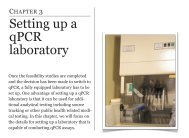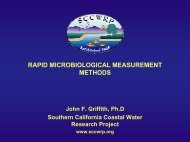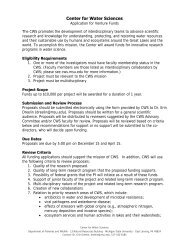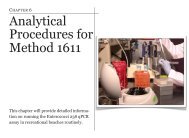Stormy Weather and Stormwater Impacts - MSU Center for Water ...
Stormy Weather and Stormwater Impacts - MSU Center for Water ...
Stormy Weather and Stormwater Impacts - MSU Center for Water ...
You also want an ePaper? Increase the reach of your titles
YUMPU automatically turns print PDFs into web optimized ePapers that Google loves.
The Workshops’ Bottom Line<br />
<strong>Stormwater</strong> runoff, the water flowing over l<strong>and</strong> from rain <strong>and</strong> snowmelt, can either be a<br />
source of pollution or an opportunity <strong>for</strong> innovation. Un<strong>for</strong>tunately, it is commonly a<br />
source of pollution. <strong>Stormwater</strong> runoff, in both urban <strong>and</strong> agricultural environments,<br />
can wash pollutants such as nutrients, pathogens, metals, <strong>and</strong> toxins off the surface of<br />
the l<strong>and</strong> <strong>and</strong> into water. According to the US Environmental Protection Agency (EPA),<br />
this is the leading cause of water quality problems in the United States today.<br />
We typically deal with stormwater<br />
by trying to get it off our property<br />
as quickly as possible. Our<br />
communities have built gutters,<br />
drains, <strong>and</strong> storm sewers to collect<br />
<strong>and</strong> convey stormwater off the<br />
l<strong>and</strong>. Where does it go? Into our<br />
rivers, lakes <strong>and</strong> streams‐ all<br />
without any prior treatment.<br />
Photo: Rachel McNinch<br />
<strong>Stormwater</strong> flows<br />
directly to waterbodies<br />
without treatment.<br />
However, there is an alternative.<br />
<strong>Stormwater</strong> can be viewed as a<br />
Photo: Michael Wagner<br />
resource, rather than as waste to be<br />
discarded as quickly as possible. By managing stormwater on site, many negative<br />
impacts can be avoided. Approaches such as Low Impact Development (LID) can be<br />
used to reduce the amount of stormwater generated at a site <strong>and</strong> to improve the water<br />
quality of the runoff. There are also opportunities <strong>for</strong> collecting <strong>and</strong> re‐using<br />
stormwater <strong>and</strong> to create artful designs that turn stormwater runoff into an amenity.<br />
This alternative just takes a shift in how we think about <strong>and</strong> deal with stormwater.<br />
The workshop participants (<strong>Water</strong> Fellows) in this <strong>Water</strong> Fellows Series have created<br />
a plan <strong>for</strong> improving Michigan’s approach to stormwater management. The<br />
workshops brought together leading national scientists <strong>and</strong> practitioners with<br />
representatives from Michigan’s many water stakeholders in government, industry,<br />
agriculture, environmental advocacy, <strong>and</strong> higher education.<br />
The recommendations summarized below outline the <strong>Water</strong> Fellows’ plan. More details about<br />
the science behind the recommendations <strong>and</strong> the workshops themselves comprise the rest of the<br />
report.<br />
1


